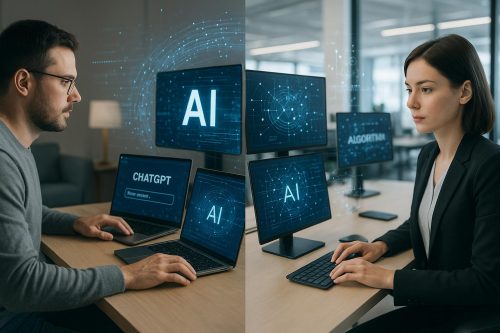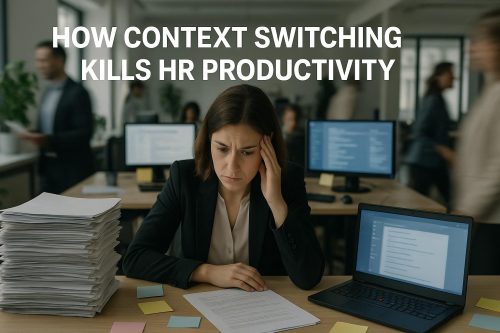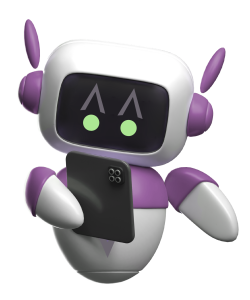These days, everyone in HR is talking about AI. You’ve got the curiosity, now it’s time for the hard part – determining how to implement AI in HR. HR pros, get ready for a detailed blueprint that makes tackling the tough stuff easier. The days of manual HR processes are numbered, thanks to the arrival of artificial intelligence. Join us as we explore the transformative power of AI in talent acquisition, employee experience, and HR team optimization – uncovering the human-centered strategies that truly drive results.
HR professionals who live and breathe technology will find this guide super useful. Imagine getting more done in less time, all thanks to the helping hand of artificial intelligence. This exploration shows you how to implement AI in HR. We’ll highlight straightforward starting points for implementing AI in HR.
The playing field is being rewritten for HR professionals.
It’s an opportunity to step up our game, automate the tasks we dislike, and tap into the creative potential of our teams to drive meaningful change.
Change is the only constant in modern workplaces, where fresh challenges give rise to new expectations and some serious rivalries. Data pours in by the bucketload, and it’s up to HR teams to make sense of it all, separating the wheat from the chaff.When they implement AI in HR, professionals can sidestep routine administrative tasks and devote their energy to the complex, interpersonal challenges that need solving. Running HR smoothly, turbocharging employee engagement, and generating data insights that sharpshoot uncertainty – that’s what this tool does best. Break free from the administrative grind and focus on adding value to your organization – you’ll be amazed at what you can accomplish when you’re not bogged down in tedious tasks.
Getting Started: Implement AI in HR
Implementing AI in human resources doesn’t have to be complex. Hammer out a clear plan to transform your HR function for good – it’s the only way to make a lasting impact.
Identify Your Needs and Goals
First, define your goals and what you want AI to achieve. You’ll make smarter choices about AI in HR with this essential guide.
Ask yourself questions: Do you want to automate routine tasks? Imagine if your organization was the one that everyone wanted to work for – what steps would you take to make that a reality? The rise of informed decision-making begs the question: what’s in store for HR’s guiding principles?
Figuring out what you really need makes all the difference when it comes to tackling HR tasks like job descriptions and training programs – you’ll get better results every time.
Start Small, Think Big
To implement AI in HR you will not need to overhaul major systems overhauls. Begin with low-risk projects to demonstrate value quickly and develop critical skills. Two ways to signal your company’s excellence are by producing top-notch recruitment content that reflects your values and by utilizing chatbots to deliver swift, personalized support.Small-scale projects reveal the AI-HR connection, rendering it far more attractive. With each skill your team grasps, the door creaks open to seriously turbocharged AI – and you’ll find yourselves confidently embracing an ultramodern workplace marked by perpetual change. With each small step, a deeper understanding of AI’s benefits is cultivated among the HR professionals and leaders.
Data is Key
AI thrives on data. Your HR data must be organized, accessible, and meet high-quality standards. Powered by AI, these HR tools expertly tackle the tough stuff in real-life scenarios.
Let’s face it, your data practices can make or break your goals – examine them, and commit to keeping your finger on the pulse of what’s new and what’s next. Can you fill in the blanks on your HR knowledge? Shrink data voids, sanitize your data sets, and re-align HR thinking around robust, real-world insights that count. Machine learning can be a total game-changer when it comes to informed decision-making – give it a try.
Where AI Can Help: Key Areas to Implement AI in HR
A study from Eightfold AI shows how organizations leverage AI in HR. Recruitment just got a whole lot smarter – thanks to AI, HR teams can now optimize their talent acquisition strategies and make better hires.
1. Hiring new staff is an exhilarating yet precarious step for any company – get it right, and you’ll reap the rewards.
Artificial intelligence zooms in on the most promising candidates by rapidly reviewing resumes and creating a condensed list of top contenders. Candidly, this thing is a trailblazer when it comes to expunging biases from the hiring process. It expertly whips up job descriptions that wow, fires off personalized messages that hit all the right notes, and innovates laser-sharp interview questions that get results. Basic tools just don’t cut it for HR pros; they need AI-infused innovations that amplify their recruiting prowess.
Time-consuming scheduling tasks disappear when you bring automation into the mix, replacing them with a seamless candidate experience that’s hard to forget. The use of AI in talent acquisition is picking up steam, streamlining every step of the way – from crafting the job description to making the final hire.
2. Onboarding
AI simplifies onboarding with employee handbooks and payroll setup. Streamlining tasks is what it does best – think shipping out offer letters,Background checks, and sifting through new hire data. The use of AI can also engage new hires during their initial days and weeks.
Bring new hires up to speed faster with AI-powered training schedules. It’s not just about sitting through a lecture – this platform gets new hires actively participating in training with interactive features. Imagine employee onboarding that’s both engaging and effective – that’s exactly what you get when interactive tools are woven into the training process.
3. Performance Management
Using AI in performance management assesses trends and encourages employee development. Identify missing skills and offer targeted training based on employee performance analysis. Two important things happen when you enhance individual learning experiences: employees gain critical skills, and your organization becomes more agile as a result.
Learning platforms fueled by AI bring a level of customization to the educational experience that was previously unimaginable. They open the door to exclusive member benefits and resources. Tailoring training to individual needs supercharges employee retention and sways the talent acquisition needle in your favor. HR teams are recognizing this when it comes to enhancing HR functions.
4. Employee Engagement
Engaged employees are more likely to stay. Chatbots powered by AI lend a helping hand with HR questions and benefits info, making life easier for employees.
Get a snapshot of your team’s mood in real-time with AI-powered surveys that peel back the layers on employee morale. This valuable information allows HR teams to get ahead of potential pitfalls and foster a positive work environment where employees thrive. Brighten up your workplace by introducing AI – it’s a powerful way to boost employee morale and keep your team on board for the long haul.
Measuring the dollar signs of bringing AI into HR – is it worth it?
Anyone trying to get AI a seat at the HR table needs to be able to talk dollars and sense. Many HR leaders find system integration a key hurdle.
| Cost Factor | Description |
|---|---|
| Software/Platform Costs | The price of AI-powered HR technology (subscriptions, licenses). |
| Implementation Costs | Expenses related to setting up, customizing software, integrating hardware, and training employees on using AI tools. Practical application of AI in HR demands that your team is ready to tackle everyday challenges. By mastering AI principles, they’ll dramatically streamline tasks and perform at a higher level, even in the most fast-paced work settings. |
| Data Migration Costs | Expenses associated with transferring HR data to new AI-compatible systems, potentially requiring outside IT support, thus requiring a deeper understanding of associated processes to effectively allocate budget resources for this stage of implementing AI in HR functions, impacting not only the technological aspect but also the strategic integration of AI tools across the entire HR function. |
| Maintenance | Ongoing costs for support, updates, and ensuring the seamless operation of AI systems. We continually invest in our AI systems to guarantee they stay relevant, efficient, and in line with shifting workplace needs and legal requirements. |
ROI from AI includes efficient recruiting, improved employee retention, lower administrative costs, and enhanced decision-making. Kick manual tasks to the curb and reap the rewards: reduced costs, more efficient employees, and a team of HR specialists who can finally spread their wings.
AI has saved 56% of HR professionals 1-3 hours daily, giving valuable time back to your team members. Gartner’s findings suggest that most HR leaders – a whopping 76% – are worried about the potential consequences of not embracing AI, specifically in terms of staying competitive with their HR approach and talent acquisition methods. Hands-on HR tasks get a much-needed assist from AI, giving professionals more time to develop valuable relationships.
Another study indicated that 93% of HR managers see cost savings with AI. When HR teams effectively integrate AI, they can significantly boost their professional standing and gain more recognition. AI technology helps them do two things exceptionally well: streamline their workflows and support sound decision-making, which ultimately pays off in achieving their organizational goals.
FAQs: How to Implement AI in HR
How do we implement AI in HR?
Implementing AI in HR is a multi-step process. Determine what you need to accomplish and plot a clear course to get there. Prioritize quick wins and integrate gradually to build support and minimize disruption.
Clean up your data act and get everything in order before moving forward. Carefully evaluate AI platforms, considering total costs and potential ROI through enhanced decision-making, automated processes, and streamlined workflows. Involve your HR team in testing and demos to determine the usefulness of specific AI solutions.
What AI tools are used in HR?
Artificial intelligence is giving human resources a serious makeover. Chatbots provide immediate employee support. Today’s AI-based recruitment platforms bring pinpoint accuracy to talent searches, and AI-driven learning platforms seamlessly pivot to respond to employees’ unique skill sets, putting critical information and tools just a click away. AI is not just augmenting HR processes; it’s sparking a deep-seated transformation that resonates throughout the entire organization. Talent acquisition and HR are getting a bold makeover, and it’s about time.
Think of these tools as your workforce GPS – they chart a course for success by identifying blind spots, sketching out training strategies, and showing you how to get the most from your people. Imagine having access to precise, data-backed information to guide your talent acquisition and workforce strategy decisions – that’s exactly what AI-powered performance management applications offer. Say goodbye to tedious HR tasks and hello to a more strategic use of resources – these tools make it all possible.
As companies opt for artificial intelligence in HR, what’s driving this digital transformation?
From HR to content creation, companies are integrating AI to boost efficiency and outcomes, One notable example is the use of AI to craft personalized employee communications that drive engagement. This exciting tool hands HR pros the power to uncover data-driven discoveries and stay ahead of workplace legal updates.
When you bring chatbots into the picture, you’ll likely notice a hike in employee enthusiasm and participation. With AI combing through worker opinions in real-time, companies can craft pointed responses to emerging office conflicts. With AI’s help, schedules are synchronized with projected needs, eliminating guesswork.
Generative AI produces training materials and summarizes documents. With AI on the job, companies can relax knowing they’re in the know about current laws – a welcome benefit for the entire organization. What happens when HR principles take center stage? A workplace where employees feel valued, and business objectives fall seamlessly into place – a true recipe for success.
Imagine if your HR team could tap into the capabilities of AI to tackle the toughest people-related challenges – it’s an exciting possibility that’s rapidly becoming a reality.
With generative AI, routine tasks like crafting job postings and surveying employees will become a thing of the past. Simplifying HR tasks is what we’re all about. Crunching employee data, the system helps shape more surgical talent acquisition approaches that hit their mark.
When AI steps in, the result is highly relevant study materials, right-on-target skills development, and clear-eyed HR direction – helping your team push boundaries. This system helps map out employee growth and surfaces areas where they need extra support or guidance. Rethinking employee development, one program at a time – that’s the promise of generative AI in HR. By putting HR principles into action, the possibilities are endless.
We’ve reached the final stretch – a moment to reflect on the crucial points.
Imagine an HR system that learns and adapts to your organization’s needs – that’s the payoff of bringing AI into the mix. Effective planning coupled with the right approach is the secret to reaching success. When all the dots are connected, HR professionals can jumpstart high-impact initiatives, energize their strategy with hard-won insights, and seize opportunities hidden in the newest workplace shifts. Take the drama out of HR by focusing on the right tech – it’s a recipe for happy, harmonious employees who love using the latest tools.
Companies using AI strategically free up time and resources. Staff are empowered to tackle high-touch, high-empathy roles that require human nuance, leaving tedious tasks to their more-routine-loving machines. Change happens when they step in, bringing a new perspective that sticks. By injecting artificial intelligence into human resources, we’re not just streamlining processes – we’re building a workforce that’s more agile, responsive, and efficient than ever before.





